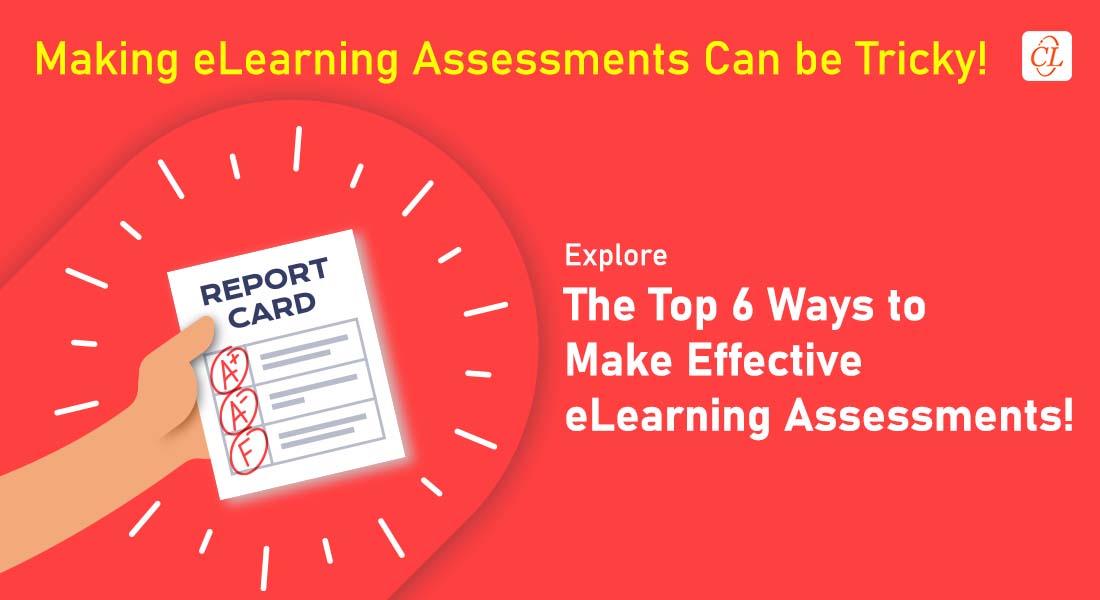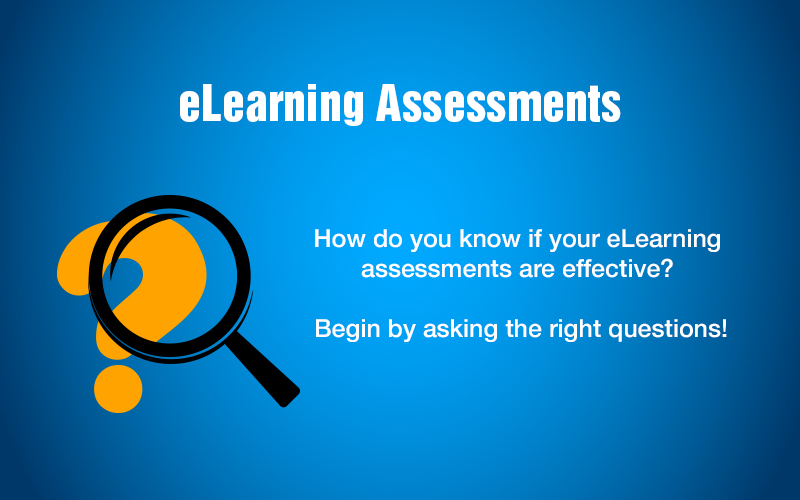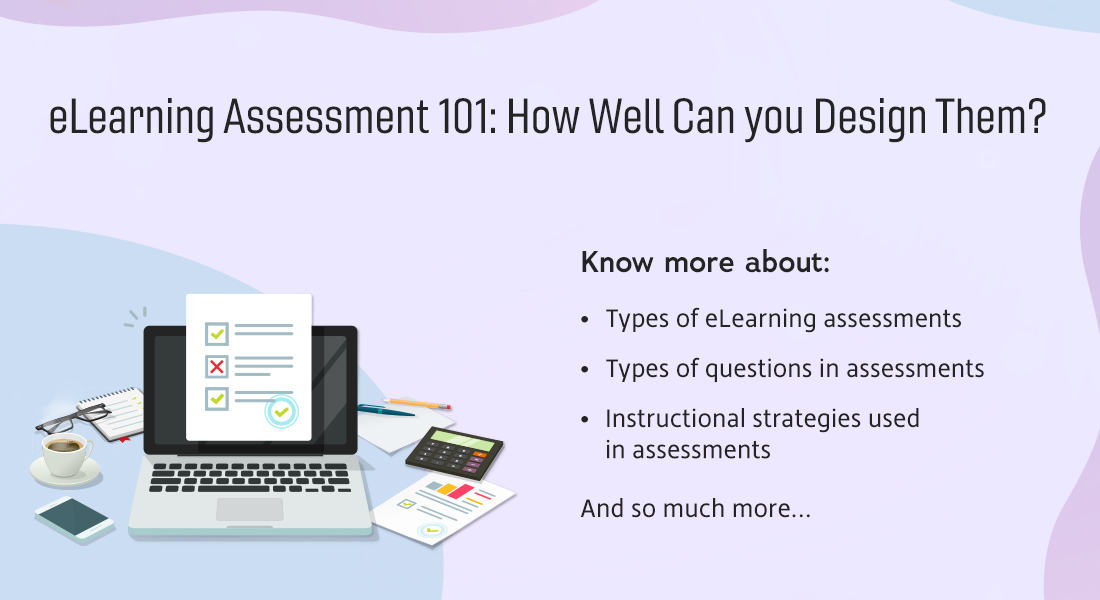Top 6 Ways to Make Effective eLearning Assessments

You might think assessments and tests hold value only in a traditional educational setting and have nothing to do with corporate training, right? Wrong! Assessing the learner’s progress holds plenty of benefits in all learning settings, be it for school students or employees in a corporate training program. Additionally, the role of eLearning assessments is crucial to understanding the learning progress of the employees and gauging their engagement, especially because there is no physical instructor.
Do You Find Designing eLearning Assessments Difficult?
Keep these six things in mind:
- Assess at every level
- Stick to the topic
- Balance difficulty levels
- Bring in variety
- Make scenario-based assessments
- Feedback is necessary
What is an eLearning Assessment and Why is it Necessary?
An eLearning assessment is a quantifiable process of testing the knowledge of the learner. The test reflects their knowledge retention, application abilities, and engagement during the eLearning program. An eLearning assessment can be designed with various testing methods such as multiple-choice questions (MCQs), drag and drop sets, match the following, scenario-based questions, gamification challenges, etc. Every online corporate training program needs eLearning assessments for the following reasons:
- Know if employees are learning
You have an LMS (Learning Management System) in place and data shows that your employees are quickly moving through their course. You often see that some parts of the course or videos are often skipped. What does this mean? Does this mean your employees already know the course material? Does this mean they find it boring? Are they acquiring the required knowledge to take on the responsibilities of the job? Assessments can answer these questions for you.
Mandating periodic eLearning assessments through the course can allow the employees to apply the knowledge they’ve mastered. Based on their performance on the assessments, training managers can keep a track of the employees’ learning. Good performance means employees already know the subject material and can move on to the next portion of the program. A bad performance may reflect the employee’s need to review the training content again. It can also be a reflection of the training module- Could the content and presentation need modification to increase learner engagement? - Testing everyone’s knowledge retention power
Consider you have an eLearning program without any assessments. How do you determine if your employees are retaining the knowledge gained through your training module? When someone is presented with a lot of information, they are quick to forget without learning how to apply it. eLearning assessments provide the learners an opportunity to use the knowledge and test their retention power. Without eLearning assessments, you will see that trainees are quickly completing their courses, but their performance does not show the expected learning curve. - Making learning more effective
eLearning assessments make learning more effective as it reinforces the information gained during the course. Well-constructed eLearning assessments provide quick feedback to the learner at regular intervals, so the learner can master every aspect of training modules. With eLearning assessments, trainees can move forward with confidence. - Breaking the course into multiple modules
Effective eLearning courses adopt spaced learning modules to break the learning process and give the learner necessary breaks to digest the information. If your employee gets smaller modules to work with, he or she will have to reflect every module completion as a checkmark for successful completion of the training program. This means, he will have to grasp knowledge from each module separately, which enhances the learning journey and increases retention. eLearning assessments are necessary tools for spaced learning programs. It allows repetition, retrieval, and reinforcement of knowledge. By asking questions and testing knowledge at every step, the trainee will show high-level of knowledge retention rate.
Learn how microlearning can help with spaced learning modules.
Things to Keep in Mind While Drafting eLearning Assessments
Now that you have understood the importance of eLearning Assessments in your corporate training program, it’s time to inculcate them in your program. However, how do you know if you are assessing your employees correctly? Here are six things to keep in mind while drafting eLearning assessments:
1. Assess At Every Level:
A weak base means a weak understanding of the whole topic. You must test at every level of training advancement to see if employees are ready to proceed. Start with a pre-training assessment to test their knowledge. Pre-training assessment reveals their learning and sets their expectations from the training program. Make use of formative assessments in between the course. It breaks the course into smaller modules and allows the trainee to use the knowledge at the end of each portion/topic.
This method reinforces learning and allows quick feedback at every point of the learning process. End the training program with a summative assessment. As the name suggests, this test sums up the course by testing the entirety of information gained in the program. These tests evaluate the trainee’s performance to take on the job. Last, but not least, consider reviewing assessments. These are post-training assessments designed to test employees’ knowledge retention after long gaps of learning.
2. Avoiding Drifting from the Topic:
Assessments should work according to the course’s goals and linked to the learning objective. If the questions asked during the assessment stray from the topic, the testing does not serve its purpose. For example, if the objective of a course is to “explain the importance of compliance.” The assessment asks the following question:
What is the morning reporting time on the site?
- 9:00
- 9:15
- 9:30
- 9:45
Now, reporting on a specific time may be a part of compliance, but does this explain the importance of compliance? No. Now, consider the following question:
Which of the following points explain the importance of compliance?
- It builds a positive reputation for the company
- Fosters safety during operations
- Improves public relations
- All of the above
The later question directly meets the objective of the course concept. When the trainee answers such questions correctly, it reflects that their learning aligned objectives.
3. Keep Difficulty Balanced:
If your employees find questions in an assessment too difficult, they will be overwhelmed before the job starts. If the questions are too easy, they will take the job lightly. This is where pre-assessment results come in handy. Make sure to understand your employee’s learning needs and knowledge bank before designing eLearning assessments for them. Ensure different difficulty levels for everyone, so they are motivated to participate and learn at every point. Use the results of formative assessments to understand where each employee needs repetition of concepts and knowledge. Do not test them beyond their understanding, nor keep them unchallenged. The unchallenging assessment also results in a lack of engagement and interest.
4. Bring In Variety:
eLearning Assessments should cater to all learning needs of the employee pool. Do not make the tests boring by using just a single type of assessment tool. Allow them a variety of testing styles such as MCQs, short format answers, true or false, fill in the blanks, etc. You can use interactive media such as audio, visuals, and video along with drag and drop features and clickables. Variety in the assessment will increase the engagement of the employees and result in better performance during the assessment. It will also keep them from dreading the testing page and rather motivate them to level up! At the end of the training program, use the data to evaluate what works for employees better when it comes to assessment styles.
5. Make Them Scenario-Based:
What is the point of theoretical learning if it cannot be put into practice? Use scenario-based quizzing methods to present the employees with real-life situations. Using scenario-based assessments in eLearning has several benefits. It levels up the difficulty, allows the application of knowledge, and enhances problem-solving and decision-making qualities. It provides a safe environment to practice future situations and understand the consequences of their actions.
Look at an example of a scenario-based quiz question below:
Mary is traveling to Africa in a couple of months. She hopes to work remotely; however, carrying her computer system could be a risk to the hardware. How can she ensure to access data from a computer there?
- Carry a USB Drive
- Upload it to a cloud-storage
- Take the computer system along
In such a case, the trainee is presented with queries that he/she may face in quotidian work-life. Provide diagnostic feedback to the assessment result to help learners understand the concept. Using scenario-based assessment makes eLearning assessments relevant to their roles in the company.
6. Feedback is Necessary:
Assessments hold no value if there is no follow-up feedback to them. Employees should receive regular feedback through the course of training. However, they must receive feedback during and after assessments. Feedback should not simply be “the answer is correct” or “the answer is incorrect.” It should explain why the answer is right or wrong so the learner can grasp the concept and avoid making the same mistake. Additionally, analyze the overall results and provide that much-needed nudge to the employees towards the right path of learning.
Additionally, take the feedback from the results of the eLearning assessment in designing future courses and assessments. Understand what works for the employees and implement the same techniques. Similarly, avoid techniques that did not contribute to the success of the training program.
Final Thoughts
eLearning assessments are a part of the eLearning program and crucial to understanding the progress of your employees in a corporate training program. Assessments benefit not only us in understanding the employee’s learning needs but also help them reinforce and retain the knowledge.
When designing an eLearning course for a corporate training program, you must include regular assessments through the course; however, designing and developing eLearning assessments can be hard! We hope the tips in this blog help you incorporate eLearning assessments in your program with ease to magnify the benefits.
Access our webinar recording, Taking the Guesswork out of eLearning Assessments, for further support in making effective eLearning assessments.



![How to Design Effective eLearning Assessments? [Infographic]](https://blog.commlabindia.com/hubfs/blogs/strategies-design-effective-elearning-assessments-info.jpg)

